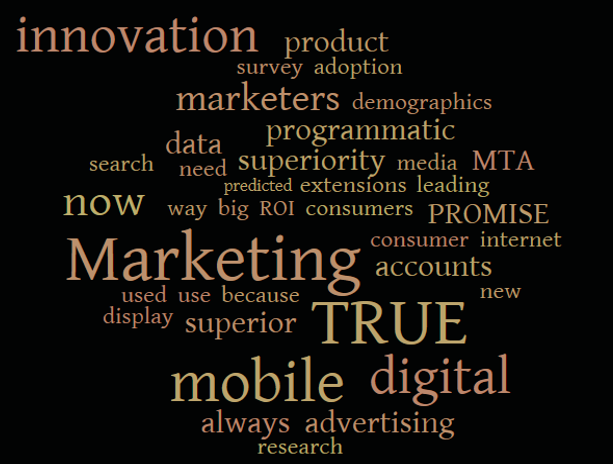In 2011, I enumerated six mandates going out to 2015 in a presentation viewed on Slideshare over 21,000 times. How well did those predictions pan out?
Understand the mobile shopper…by 2015 mobile will dominate internet access.
TRUE. In 2011, computers were still dominant but I saw the handwriting on the wall. According to comScore, mobile now accounts for over 2/3rds of internet media time. And other research has shown that nearly 60% of shoppers use their mobile devices while in physical stores. Programmatic mobile advertising accounts for the majority of mobile display advertising, and the bids always have longitude and latitude associated so smart retailers can geo-fence their messaging.
Surveys are not enough. We need big data insights.
MOSTLY TRUE. This one has developed slower than I thought, but clearly the industry is moving in this direction along two paths. A number of leading research panels now offer connections to databases (e.g. Experian, Acxiom, IRI Proscores, eXelate) so that a respondent’s answers can be enriched with data used for digital targeting. Marketing Evolution is probably the most progressive analytics company in this area, with connections to big data valued in the millions of dollars. The other path is integration of different data streams for a comprehensive brand KPI approach. This is already in practice for some such as Coca-Cola using a system I helped them to create.
Media buys should be based on behaviors not demographics
MOSTLY TRUE. This is the direction for sure. As we browse on any device, we create digital bread crumbs about what we are interested in, not to mention “search” which gives direct evidence of our current interests that marketers can address. This all creates digital profiling variables that are the backbone of programmatic marketing which now accounts for the lion’s share of display advertising. Increasingly, the role of demographics will change to becoming modeling ingredients into superior definitions of target segments that can be used to differentiate the value to a marketer of different users, acted on programmatically.
Brands need to be everywhere.
TRUE. Marketing teams now will use the phrase “always on marketing”, acknowledging that many touchpoints along the consumer journey are initiated by consumers. In always on marketing, your brand needs to be accessible to consumers when THEY choose to seek YOU out! It’s a 180 degree reversal of the flow of the marketing communications process!
There will be a new set of brand metrics and ROI approaches for a digital age.
Mostly true. ROI measurement has seen the emergence of a whole new class of tools called “Multi-touch attribution” (MTA). I have been studying and assessing these methods for 8 months, consulting with the Mobile Marketing Association on the MATT initiative. MTA adoption is predicted to hit 75% of marketers by 2019 because it is the only way that marketers will get digital and programmatic right. Marketing Mix Models won’t get us there and in fact, the leading MMM providers are now offering companion MTA services.
Reward true innovation more than line extensions.
SOMEWHAT TRUE. CPG marketers are still fixated on line and franchise extensions because that strategy offers more affordable and less risky ways of introducing new products. A real impediment to innovation is a mentality of equating innovation with a search for product superiority. Innovation should focus on innovating the consumer experience and the way we live our lives. Innovation is not about product superiority as much as PROMISE superiority and then just delivering on the promise. iPod was not a superior product but a superior PROMISE. The same goes for Alexa and Nest. In digital, it is rapid adoption of true innovation that drives stock price.
Two big things I missed in 2011…
I didn’t use the word “programmatic”. I talked about data driven marketing but programmatic is the embodiment of its power. As an illustration, recently, I defined a new segmentation strategy that was proven on multiple campaigns by frequent shopper data to deliver more than 10X the lift in sales by targeting one of the 8 segments. Such targeting is completely achievable via programmatic.
Automation. The force for this is strong and will intensify over time, as marketers and researchers struggle with flat budgets and the need to wring any unproductive costs out of the system. This includes the “boxing up” of affordable versions of research methods, like Zappi-store. It also includes AI and machine learning. Of course, it also includes programmatic advertising.
And what is the priority for 2017?
As I said in my last blog, number one is a commitment to user based marketing or what I call “bottom up” marketing. From this, 3 specific initiatives will flow. 1) A commitment to a DMP based on unified IDs rather than cookies. 2) Understanding how to drive up your brand’s relevance based on where people are in their consumer journey. 3) Making MTA work for you. There will be a huge impact on marketing ROI when you get MTA right but it could take a year or more, so start now. And researchers, puh-leez…stop conducting surveys that are not linked to digital action variables. You need to become part of this transformation.

